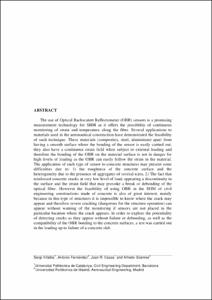Mostra el registre d'ítem simple
Feasibility of structural health monitoring of concrete structures by optical backscatter reflectometer
| dc.contributor.author | Villalba Herrero, Sergi |
| dc.contributor.author | Fernández López, Antonio |
| dc.contributor.author | Casas Rius, Joan Ramon |
| dc.contributor.author | Güemes Gordo, Alfredo |
| dc.contributor.other | Universitat Politècnica de Catalunya. Departament d'Enginyeria de la Construcció |
| dc.date.accessioned | 2010-05-12T15:24:27Z |
| dc.date.available | 2015-03-25T16:12:30Z |
| dc.date.created | 2009-09 |
| dc.date.issued | 2009-09 |
| dc.identifier.citation | Villalba, S. [et al.]. Feasibility of structural health monitoring of concrete structures by optical backscatter reflectometer. A: International Workshop on Structural Health Monitoring. "The 7th International Workshop on Structural Health Monitoring". 2009, p. 1-8. |
| dc.identifier.uri | http://hdl.handle.net/2117/7188 |
| dc.description.abstract | The use of Optical Backscaterr Reflectometer (OBR) sensors is a promising measurement technology for SHM as it offers the possibility of continuous monitoring of strain and temperature along the fibre. Several applications to materials used in the aeronautical construction have demonstrated the feasibility of such technique. These materials (composites, steel, aluminium) apart from having a smooth surface where the bonding of the sensor is easily carried out, they also have a continuous strain field when subject to external loading and therefore the bonding of the OBR on the material surface is not in danger for high levels of loading as the OBR can easily follow the strain in the material. The application of such type of sensor to concrete structures may present some difficulties due to: 1) the roughness of the concrete surface and the heterogeneity due to the presence of aggregates of several sizes, 2) The fact that reinforced concrete cracks at very low level of load, appearing a discontinuity in the surface and the strain field that may provoke a break or debonding of the optical fiber. However the feasibility of using OBR in the SHM of civil engineering constructions made of concrete is also of great interest, mainly because in this type of structures it is impossible to know where the crack may appear and therefore severe cracking (dangerous for the structure operation) can appear without warning of the monitoring if sensors are not placed in the particular location where the crack appears. In order to explore the potentiality of detecting cracks as they appear without failure or debonding, as well as the compatibility of the OBR bonding to the concrete surfaces, a test was carried out in the loading up to failure of a concrete slab. |
| dc.format.extent | 8 p. |
| dc.language.iso | eng |
| dc.subject | Àrees temàtiques de la UPC::Enginyeria civil::Materials i estructures |
| dc.subject.lcsh | Structural health monitoring |
| dc.title | Feasibility of structural health monitoring of concrete structures by optical backscatter reflectometer |
| dc.type | Conference report |
| dc.subject.lemac | Estructures de formigó -- Manteniment i reparació |
| dc.contributor.group | Universitat Politècnica de Catalunya. TE - Tecnologia d'Estructures |
| dc.contributor.group | Universitat Politècnica de Catalunya. GRIC - Grup de Recerca i Innovació de la Construcció |
| dc.description.peerreviewed | Peer Reviewed |
| dc.rights.access | Open Access |
| local.identifier.drac | 2434933 |
| dc.description.version | Postprint (author’s final draft) |
| local.citation.author | Villalba, S.; Fernández López, A.; Casas, Joan R.; Güemes Gordo, A. |
| local.citation.contributor | International Workshop on Structural Health Monitoring |
| local.citation.publicationName | The 7th International Workshop on Structural Health Monitoring |
| local.citation.startingPage | 1 |
| local.citation.endingPage | 8 |


